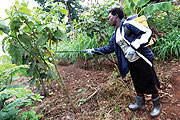The tale of two people’s lives transformed through agricultural support Like her parents, and their parents before them, and theirs before them Juliette, 25, farms. Her few acres of land are scattered across the hillside and down into the valley bottom around Rugina, a rural village in the far southeast corner of Rwanda.


The tale of two people’s lives transformed through agricultural support
Like her parents, and their parents before them, and theirs before them Juliette, 25, farms. Her few acres of land are scattered across the hillside and down into the valley bottom around Rugina, a rural village in the far southeast corner of Rwanda.
It is beautiful here: lush green interspersed with red soil cover the corrugated hills that rise steeply then drop away into the next valley.
Trees cover the most precipitous slopes, the rest are terraced and cultivated. In the swampy valley floors a thick morning mist blankets the rice paddies where families grow the food they survive on.
Rwanda is one of Africa’s most densely populated countries. Competition for resources was a factor in the 1994 genocide against the Tutsi in which over one million people were killed. Juliette’s mother was one of those murdered – her father had died years before – leaving the surviving children to fend for themselves on the family plot.
Aged only 10 Juliette continued to live and farm with her orphan family of two girls and two boys. They were scraping a living until the DFID-backed PAPSTA programme (the French acronym for the ‘Support Project to the Strategic Plan for Agricultural Transformation’) started in 2007.
"We were living then, but at a lower standard than now,” recalls Juliette. "PAPSTA has trained us to farm better and increase production so we can feed ourselves better.”
Four out of every five Rwandans farm and agriculture accounts for up to 40 percent of GDP. PAPSTA helps intensify farming by teaching better farming practices, donating cows and providing fertilizer.
Results have been impressive, improving the lives of rural folk in a very direct way. In Juliette’s small mud-walled house three 100kg sacks of rice are waiting to be sold, proof of PAPSTA’s success.
At a nearby village 40-year old father of six Ramadhan is a living model of modern farming practice. His fertilizer-fed vegetable patch bursts with rows of onions and beetroot, plump cabbages and fragrant parsley, carrots, aubergines and tiny red-hot chili peppers.
He collects rainwater in a seven cubic metre sack-lined reservoir, makes manure for spreading on his fields, and has a ‘kitchen garden’ which looks like a neat compost heap erupting with growing green peppers.
"PAPSTA has taught us intensive agriculture methods so we can produce a lot in a small space. Now we have enough food and even produce a little for the market,” says Ramadhan.
In his rice paddy Ramadhan and his wife Amina, 39, use fertilizer to increase the yield and have learned to plant individual seeds rather than using what he calls "the broadcast method” of simply flinging seeds all over the swamp.
"Now we produce more at harvest and use fewer seeds,” he explains simply. "In the old days I would harvest one tonne, now it is double.” The heavy sacks of rice and beans piled in his storeroom attest to the success of his harvest.
"Our nutrition has improved,” Ramadhan says, "we have more rice, more vegetables and we have milk.”
PAPSTA gave both Ramadhan and Juliette a cow each which provides nutrient-rich milk to drink and extra to sell.
"It enables us to buy other foods that we don’t grow and,” Juliette said excitedly, "today I have been able to buy a bicycle!”
She will use the bicycle to bring piles of fodder to feed her cow and to collect water from the village pump, an essential activity that dominates the lives of rural people who must spend hours everyday ferrying drinking water from the communal borehole.
And with that Juliette grins and races off down the hill on her new bike, bumping along the muddy path, an empty water-can strapped to her back.


